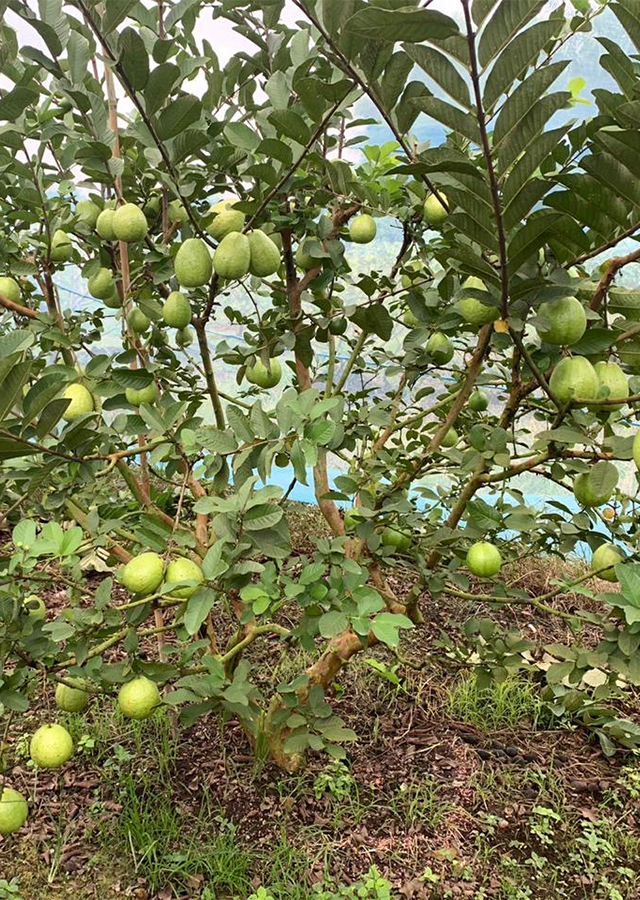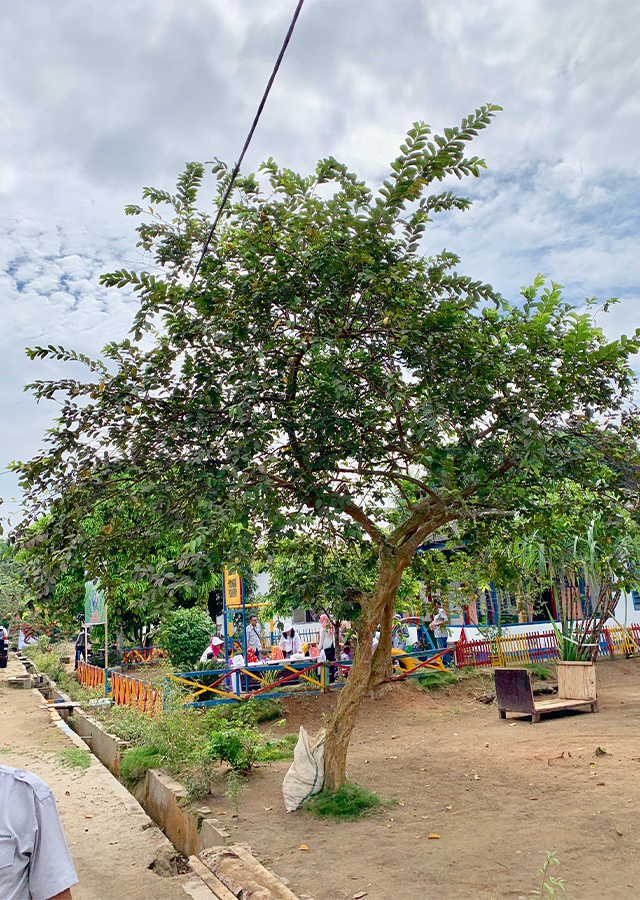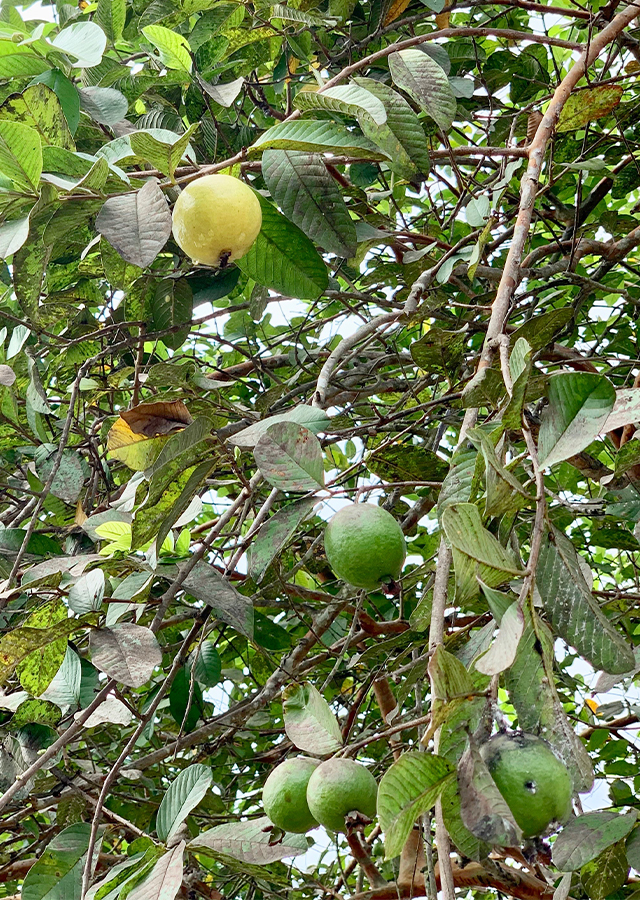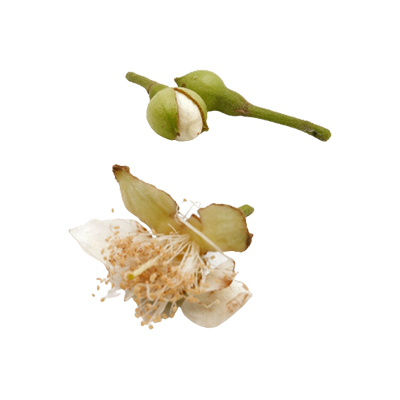Guava
Psidium guajava L.
Myrtaceae
Location in our garden
Orchard



Synonym
Guajava pumila (Vahl) Kuntze
Guajava pyrifera Kuntze
Myrtus guajava (L.) Kuntze
Habitus
Trees. Evergreen shrub or small tree with a lot of strong branches that grows up to 15 m in height.
Part Used
Leaves
Bark
Flowers
Fruit
Roots
Growing Requirements
Full Sunshine
Drought Resistant
Habitat
Terrestrial
Overview
Guava is indigenous to the American tropics. In the opinion of De Candolle it originates from the area between Mexico and Peru. The Spaniards took it across the Pacific to the Philippines and the Portuguese introduced it from the West to India. Called the ‘apple of the tropics,’ guava is considered to be one of the most exquisite, nutritionally valuable, and remunerative fruit crops of tropical and subtropical regions of the world.
Vernacular Names
Jambu biji (Indonesia), Bayabas (Tagalog-Philippines), Farang (Thailand), Amarood (India), Fan shi liu (Chinese), Guaia giallo (Italian), Guayaba agria (French).
Agroecology
P. guajava is a hardy tree that adapts to a wide range of growing conditions. In the tropics the tree is found from sea level to an altitude of about 1,500 m, the optimum yield occurs in regions with a mean temperature range of 20-30 °C. Its original habitats are savannah/shrub ecotones or frequently disturbed land.
Morphology
- Stem - smooth, green to red-brown, peeling off in thin flakes.
- Leaves - opposite, glandular, blade elliptical to oblong, glabrous above, finely pubescent beneath, veins prominent below.
- Flowers - solitary, axillary, irregular, persistent, stamens numerous, stigma capitate.
- Fruits - berry, globose, ovoid or pyriform, surmounted by the calyx lobes; exocarp gree to yellow; mesocarp fleshy, white, yellow, pink or red, with stone cells, sour to sweet and aromatic.
- Seeds - numerous, embedded in pulp, yellowish, bony, reniform, 3-5 mm long.
Cultivation
- Propagated by seeds - the seed germinates well, within 15-20 days from sowing and the seed remains viable for a long time.
- It is also propagated by cuttings and grafting.
Chemical Constituents
Phenolic compounds, terpenes, caryophyllene oxide, p-selinene, acetylcholine, flavonoids (quercetin), guajanoic acid, β-sitosterol, uvaol, oleanolic acid, ursolic acid, beta carotene, thiamine, ribovlavin, niiacin, choline, vitamin C, vitamin K.
Traditional Medicinal Uses
Medicinal Uses
- Bark and leaves are astringent and vulnerary.
- Studies have suggested antibacterial, antifungal,
- antioxidant, antihypertensive, antidiarrheal, hypoglycemic, antitumor, trypanocidal, antiproliferative, antispasmodic, hypocholesterolemic, hypoglycemic, hepatoprotective, anti-solar, gastroprotective, analgesic, antipyretic, hematopoietic, anti-plaque, nephroprotective, immunomodulatory properties, anti-inflammatory and haemosttatic agent.
Traditional Uses
- The leaves are widely used traditionally for treating bacterial infections in South Africa and in Guinea (West Africa) for infectious diseases.
- In India, it is reported that locals recommend drinking hot water with the bark powder mixed into it as a remedy for blood-associated dysentery.
- In Northeastern Nigeria, decoction of the leaves mixed with pineapple and honey is used as a local remedy for malaria. The barks are used as remedy for tuberculosis.
- The leaves are also used in Tanzania for treating tuberculosis in patients with HIV-AIDS.
Part Used
Reference Sources
- CABI. (2013). Invasive Species Compendium. Psidium guajava(guava). https://www.cabi.org/isc/datasheet/45141. 08-02-2021
- NCBI. (2017). Psidium guajava: A Single Plant for Multiple Health Problems of Rural Indian Population. https://www.ncbi.nlm.nih.gov/pmc/articles/PMC5628524/#:~:text= Although%20guava%20has%20a%20number,the%20world%20for%20these%20ailments. 08-02-2021
- Pl@nt Use. (2016). Psidium guajava (PROSEA). https://uses.plantnet-project.org/en/Psidium_guajava_(PROSEA) 08-02-2021
- Sciencedirect. (2008). Psidium guajava. https://www.sciencedirect.com/topics/agricultural-and-biological-sciences/psidium-guajava. 08-02-2021
- StuartXchange. (2016). Philippine Medicinal Plants. Bayabas. http://stuartxchange.ph/Bayabas. 08-02-2021
- Kumari N., S. Gautam, and C. Ashutosh. 2013. Psidium guajava A Fruit or Medicine - An Overview. The Pharmma Innovation Journal 2(8): 63-67




